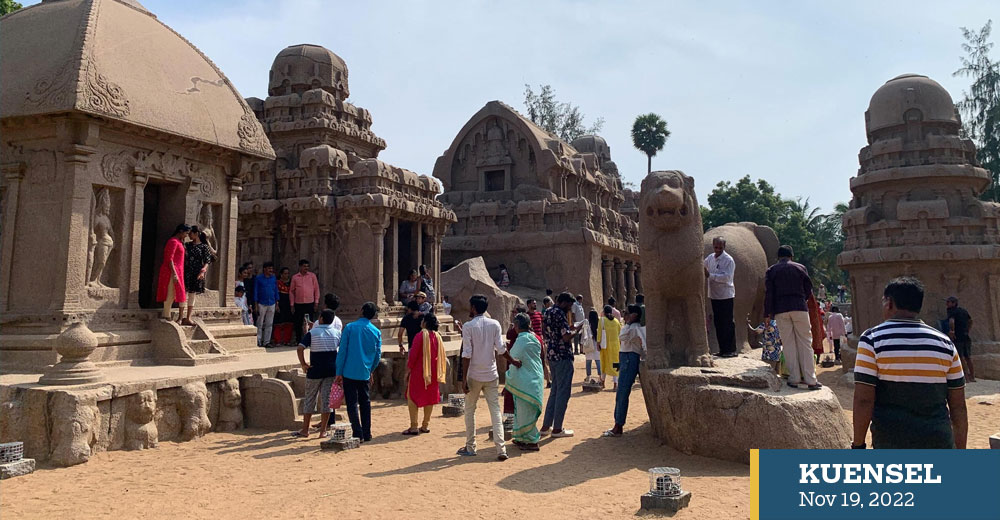Bhutan’s tangible culture could be at risk with skills disappearing rapidly
Yangyel Lhaden
Mahabalipuram in Tamil Nadu is one of the many UNESCO World Heritage Sites in India. It is a must-visit place if you are in south India.
Mahabalipuram is about 50km away from Chennai, the capital city of Tamil Nadu. I knew that there was an hourly direct bus service to Mahabalipuram but there wasn’t when I decided to visit with my friends. So, taking the conductor’s advice, we switched buses.
World Heritage Sites are landmarks with legal protection by an international convention administered by the United Nations Educational, Scientific and Cultural Organization. The sites are designated by UNESCO for having cultural, historical, scientific or other significance. Out of the 40 world heritage sites in India, four are in Tamil Nadu. Mahabalipuram was declared a UNESCO world heritage site in 1984.
If you need reminding that you are in the far south of India, a bus ride is the best experience—relentless Tamil songs blaring through the speakers, coconut and banana trees everywhere…Vanakkam!
The bus dropped us at a place 10 km away from Mahabalipuram. A taxi from there to Mahabalipuram cost Rs 600. So we took an auto, just for Rs 30. Because this is India, there is no passenger limit, even in an auto. We were 12 of us midway to the destination.


Concerned, I had to ask the driver: “Can your tyre take the pressure?” I was quickly reminded by one of the passengers that this is normal on the road to Mahabalipuram. “It is the journey that is more important.”
Suddenly, I heard a loud bang. I covered my head instinctively and looked around slowly. It was a tyre burst! Embarrassed, Mahi, our auto driver, promised to show us more interesting parts of Chennai and lunch at a fisherman’s colony. I also saw genuineness in his eyes. But we took a bus ride to Mahabalipuram.
I’d already been to the fisherman’s colony. The small and colourful houses in yellow, green, and pink are a feast to the eye. It’s a world of its own. There are countless restaurants serving fresh seafood. I remember sitting on a balcony and devouring fresh fish and pizza with a view of the endless ocean. It’s a beautiful place—hard to argue it is not.
So, for the monument tour, we called Mahi who arrived promptly. He had taken English lessons while working as a chef. An auto driver for tourists makes more money. So Mahi became an auto driver for tourists.
Mahabalipuram was one of the two major port cities in the heyday of the Pallava kingdom. Mahi was quick to tell us that along with economic prosperity, Mahabalipuram became a site for royal monuments, many carved out of solid rock.
Mahabalipuram is known for its stone sculptures of Davidian culture. They were designed by Pallava kings who ruled parts of Tamil Nadu from the sixth century. All four types of stone structures in India— cave temples, carved monoliths, sculpted scenes, and masonry—can be found here.
The first monument that I laid my eyes on was the Five Rathas or five chariots. A single rock was used to carve this beautiful structure.
There are about 40 monuments in Mahabalipuram. We visited Arjuna’s penance, Pancha Paandave cave, Krishna Mandapa, Krishna’s butterball, Lighthouse, Iswara Temple, and Shore Temple.
Just a week ago, I read a story about the consecration of the Druk Khamsum Wangdue Choeki Phodrang. The Wangdue Dzong is the most unique dzong in Bhutan. What the builder and skilled workers have achieved in eight years is truly amazing.
Sometimes I wonder how we could be losing such skills that have defined who and what we are. Mahabalipuram was an object lesson for me.


